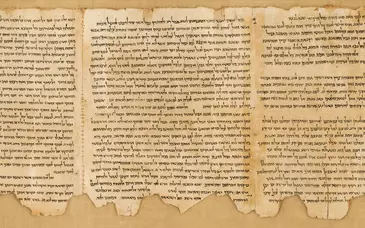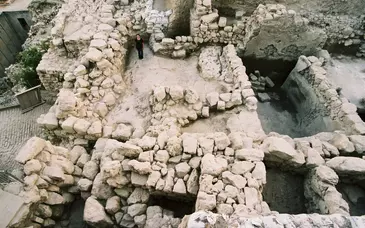Nabonidus was the last king of the Neo-Babylonian Empire, reigning from 556 to 539 B.C.E. Beset by political problems and economic difficulties in Babylonia, Nabonidus decided to appoint his son Belsharusur as regent ("King Belshazzar" in the Bible: Dan. 5:22; 7:1; 8:1), while he himself moved west to Teima, an oasis in northwest Arabia. By removing to this locality, the king hoped to secure the trade routes from southern Arabia and thereby to ameliorate his money problems. He remained in Teima for a full decade, establishing garrisons and planting colonies to the south of his base of operations. Among these colonies were five oases that, at the time of Muhammad a millennium later were occupied by Jews. Almost certainly, then, Nabonidus had a strong contingent of Jews among his colonists, whether drawn from those m exile in Babyloma or from those left behind in Judah. The presence of "a Jew, a member of the community of exiles" in the scroll here translated may be an accurate memory of this historical situation.
The king's ten year absence from the capital city is probably the basis for th~ tale our scroll recounts. In turn, the correspondences between the scroll and the story told in Daniel~4 about the much more famous king, Nebuchadnezzar, are systematic and striking. These similarities have convinced most scholars that in some fashion the present story lies behind the biblical episode. If that theory is right, it would mean that we have discovered in this scroll a previously unknown Source for the Bible. The story in this scroll would then antedate 200 B.C.E., and could be a century or two older. The change of names, from Nabonidus to Nebuchadnezzar, was not done to protect the innocent, but to implicate" the guilty. Nebuchadnezzar, of course, was the Neo-Babylonian king who had sacked Jerusalem, burned the Temple, and carried the people into exile in 586 B.C.E. Likewlse, the change from Nabonidus's "inflammation" to Nebuchadnezzar's lupine madness in Daniel 4 represents a raising of the stakes an increase in the tension the storyteller hoped to create.
Eventually, King Nabonidus returned to Babylonia but was overthrown by the forces of the Persian empire builder, Cyrus. A form of that story appears in our Bibles in Daniel 5.
The actions of the Jewish exorcist described in our scroll accord exceedingly well with what we read about the figure of Daniel in the biblical book of the same name. Scholars have convincingly suggested that there once existed a "Daniel cycle" that included more storiespossibly quite a few more than have survived in our Bibles. This would be one of them, as would The Vision of Daniel (text 40) and, perhaps, The Vision of the Four Trees (text 120). Further, bearing in mind the many New Testament parallels, the exorcism described here may profitably be compared with that carried out by Abraham in the Tales of the Patriarchs (text 2) and the actual wording of an exorcism preserved in text 122.
Nabonidus confesses his sins and explains how he was healed.
Frags. 1-3 IThe words of the pra[y]er of Nabonidus, king of Babylon, [the great] kin[g, when he was smitten] 2with a severe inflammation at the command of G[o]d, in Teima.
[I, Nabonidus,] was smitten [with a severe inflammation] 31asting seven years. Beca[use] I was thus changed, [becoming like a beast, I prayed to the Most High,] 4and He forgave my sins. An exorcist a Jew, in fact, a mem[ber of the community of exiles came to me and said,] 5"Declare and write down this story, and so ascribe glory and gre[at]ness to the name of G[od Most High." Accordingly, I have myself written it down:] 6I was smitten with a severe inflamation while in Teima, [by the command of God Most High.. Then] 7for seven years I continued praying [to] the gods made of silver and gold, [bronze, iron,] 8wood, stone, and clay, for I [used to th]ink that th[ey] really were gods.

